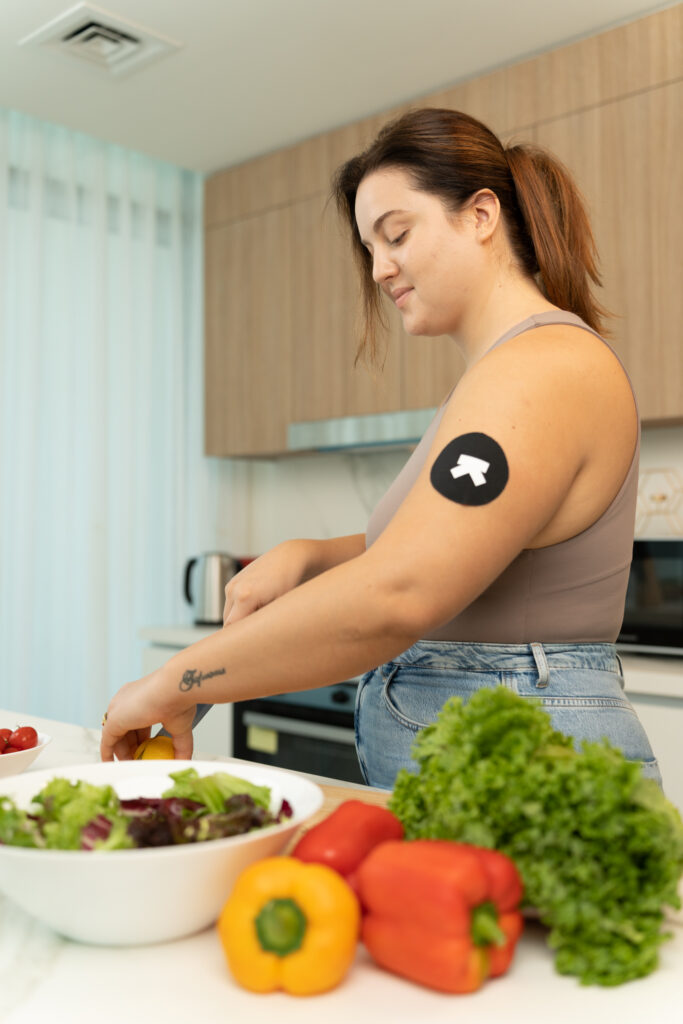Women with polycystic ovary syndrome (PCOS) often feel tired, lethargic and fatigued, which can be linked to insulin resistance.
As per a study, around 65-70% of women with polycystic ovary syndrome (PCOS) are insulin resistant. This means that their bodies do not respond to insulin as they should, and the cells aren’t able to take up glucose from the blood. As a result, their glucose levels stay elevated. Over time, this can lead to prediabetes, type 2 diabetes, cardiovascular diseases, etc.
By making the right lifestyle choices with exercise, stress management and a well-balanced diet, you can avoid the risk of developing prediabetes and type 2 diabetes. For those with PCOS, improving insulin sensitivity could also reverse several PCOS symptoms and improve fertility. Let’s see how a healthy, balanced diet can be life-changing and talk more about how to eat foods that can help you manage your PCOS.

Highlights
- A study has established that a large percentage of women with polycystic ovary syndrome (PCOS) are insulin resistant.
- This means that they run at a higher risk of developing prediabetes, type 2 diabetes, heart disease and so on.
- By managing their blood glucose levels, focusing on incorporating nutrient-dense foods and eating their food in the ‘right’ order, they can increase insulin sensitivity and reverse many symptoms of PCOS.
Eat foods that keep your blood glucose levels stable
For breakfast, most people tend to reach out for whatever takes the least amount of time to prepare, such as juices, smoothies, muffins, bread, cereal, and pancakes—you get the gist. And while these food items can be extremely delicious and tempting, they typically have a low-fibre and high-sugar content which can cause your blood sugar levels to spike, causing you to feel lethargic, tired and fatigued throughout the day.
A study that used continuous glucose monitoring found that around 80% of non-diabetics experience glucose spikes (over 140 mg/dL) from common food items (such as the ones mentioned above). This means that even if you fall in the non-diabetic category, chances are that the food items that you typically consume (a “harmless” croissant or a glass of apple juice) are causing a spike in your blood glucose levels.
This is why choosing foods for your breakfast that keep your glucose levels stable is vital. So, instead of your everyday granola bars, cereal, juices and smoothies, choose whole fruit, smoothies with fat and protein, high-fibre cereal or oats paired with full-fat yoghurt/greek yoghurt, nuts and seeds. Avoid instant oats, as these are highly processed and can spike your blood sugar, and choose steel-cut oats or rolled oats instead.
Likewise, pick a savoury breakfast of eggs, chicken, veggies and nut butter instead of a sweet breakfast of bread and jam. When you have a savoury breakfast, you avoid glucose spikes and steady your glucose levels. A clinical trial found that a very low-carb and high-fat breakfast lowered postprandial (after a meal) glucose excursions. This approach can help improve glycemic variability (meaning fluctuations in blood glucose levels over a period of time) and lower postprandial hyperglycemia.
The same rules can be followed for lunch, snacks and dinner. The focus should be on incorporating protein, fibre and fat into every meal to stabilise glucose levels. So, for instance, if you want to reach out for an apple as a snack, you can add a dollop of peanut butter or almond butter and sprinkle some cinnamon powder on top. The key is to pair starches/carbs with fibre, protein and fat to curb glucose spikes.

Pick homemade meals over takeout/fast food
Home-cooked meals are healthier and more nutritious than fast food items. When you make things at home, you have more control over what goes into your meals. You can easily swap one relatively unhealthy ingredient with a healthier one.
Consuming food items that have high amounts of sugar can spike glucose levels in the blood. This is why it’s crucial to read store-bought items’ labels and avoid those with high sugar content.
Vinegar (acetic acid) before meals
Having vinegar (acetic acid) before meals is a sneaky hack to avoid glucose spikes. As per a review of a few studies done on the subject, the acetic acid present in vinegar slows down the emptying of food from the stomach into the small intestine. This, in turn, slows down the breakdown of carbs and allows the body to have more time to get rid of the glucose in the bloodstream.
In the end, it reduces glucose spikes that one would typically see after a meal. In a randomised controlled trial, it was found that when a meal consisting of white wheat bread was supplemented with vinegar, the postprandial responses to glucose and insulin were reduced, and the subjective rating of satiety was increased.

Picking portions
Most of us are so focused on counting calories that we overlook the essential nutrients in our diet. The right portion sizes ensure that you are fulfilling your body’s needs and getting adequate nutrients to heal. It is best to divide the plate into portions visually for a well-balanced meal.
About half of the plate can be reserved for fresh veggies such as lettuce, tomatoes, kale, spinach, broccoli and arugula. Ensure that the other half of the plate includes a considerable portion of protein, fibre and fat. Choose chicken, fish, eggs and beans for a quarter of the plate and whole grains for the remaining quarter. Consult a nutritionist to learn more about proper portion sizes.
The sequence of food matters
The sequence in which you eat your food also makes a huge difference in your blood sugar levels. Previous studies have found that having veggies or protein before carbs could be a great way to reduce post-meal glucose levels. They also found insulin to be notably lower when consuming vegetables and protein first.
The ideal way to go about this is to start your meals with veggies or a high-protein salad. Make sure to avoid adding store-bought dressings and sugar-laden sauces on top. Having sweets on an empty stomach can give you an instant spike in your glucose levels, which is why it’s recommended to save sweets for dessert, i.e., at the end of a meal.
Conclusion
The ideal diet for women with PCOS is one that helps them keep their glucose levels steady and increases insulin sensitivity. Increasing insulin sensitivity could also improve energy levels and reverse symptoms of PCOS such as fatigue, cravings, acanthosis nigricans, etc. A well-balanced diet can be life-changing—it can support fertility and improve the quality of life of individuals.
Minimising the intake of low-fibre, high-sugar foods and pairing starches/carbs with fibre, protein, and fat can help curb glucose spikes. Consuming vinegar (acetic acid) slows down the breakdown of carbs and gives your body more time to get rid of the glucose in the bloodstream. Similarly, home-cooked meals allow you to have more control over ingredients and easily replace unhealthy ingredients with healthy ones.
Disclaimer: The contents of this article are for general information and educational purposes only. It neither provides any medical advice nor intends to substitute professional medical opinion on the treatment, diagnosis, prevention or alleviation of any disease, disorder or disability. Always consult with your doctor or qualified healthcare professional about your health condition and/or concerns and before undertaking a new healthcare regimen including making any dietary or lifestyle changes.
References
- All Women With PCOS Should Be Treated For Insulin Resistance – PMC
- Glucotypes reveal new patterns of glucose dysregulation
- Restricting carbohydrates at breakfast is sufficient to reduce 24-hour exposure to postprandial hyperglycemia and improve glycemic variability
- Vinegar (acetic acid) intake on glucose metabolism: A narrative review
- Vinegar supplementation lowers glucose and insulin responses and increases satiety after a bread meal in healthy subjects







